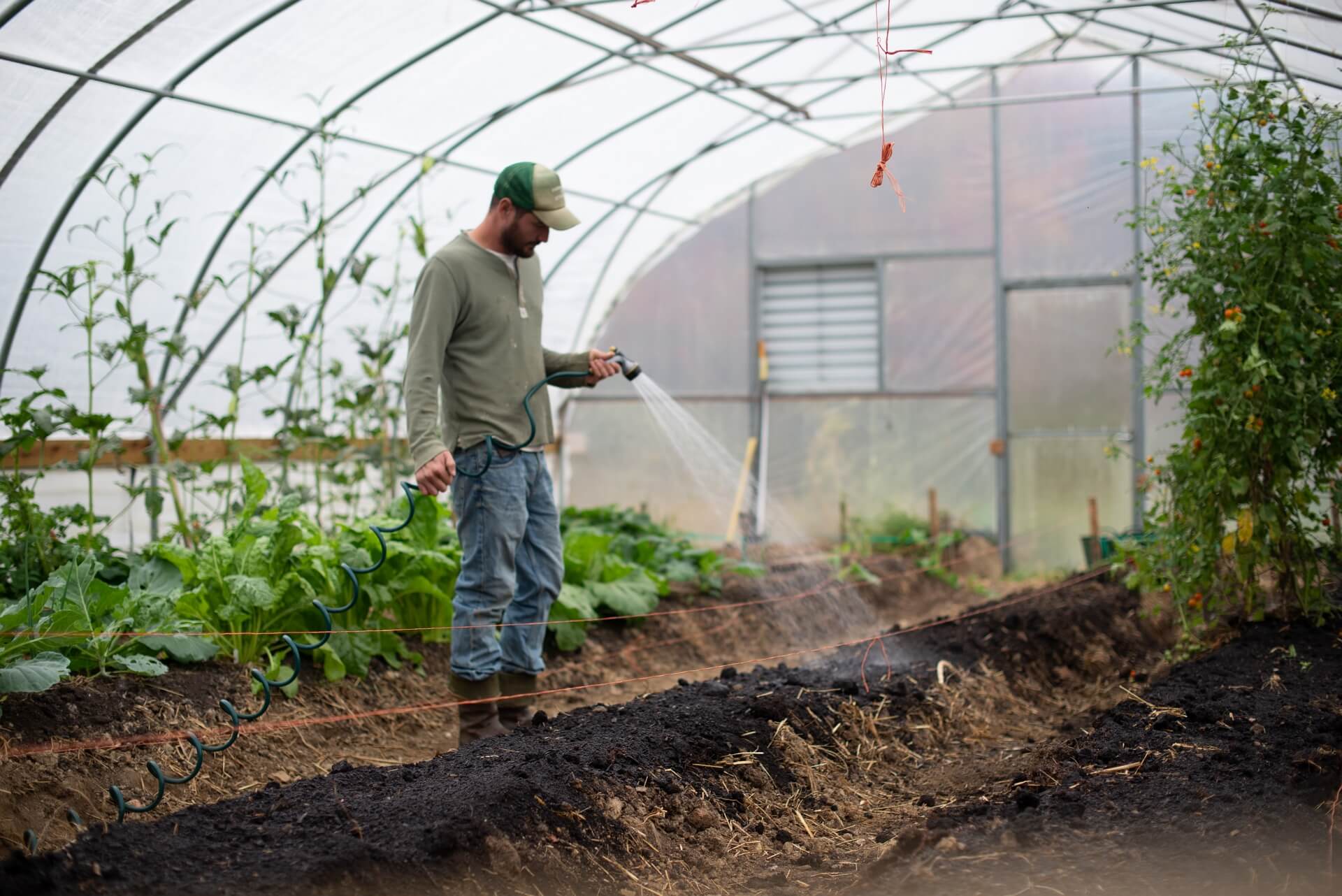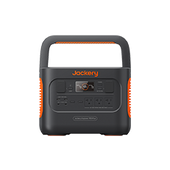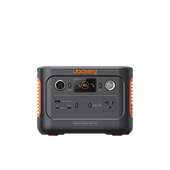Greenhouses use the sun's light and warmth inside the structure to produce an environment that is more favorable for plant growth than the outside environment.
The greenhouse setup consumes up to 150 Watts with all the lights and heaters on. It fluctuates throughout the day between 50W and 120W, with an hourly electricity expense of between $0.5 and $2.
The solar-powered greenhouse not only saves the cost of powering heating and lighting system but also prevents greenhouse emissions. There are several types of solar greenhouses, and here recommend Jackery solar generators as your greenhouse power source. On this page, you will learn what a solar-powered greenhouse is, how it works, and the solar-powered greenhouse vs. solar generator for a greenhouse.
What is Solar Powered Greenhouse
The amount of people using solar technology in agriculture has increased. A greenhouse with solar panels placed is referred to as a solar-powered greenhouse. They gather the sun's energy and convert it into heat. Even in unfavorable climatic conditions, it offers the proper environment for plant growth.
A solar greenhouse spreads the thermal energy that the sun's energy transforms into. It requires collectors, which can be solar heat absorption panels or photovoltaic (PV) panels, to accomplish this. But a solar energy greenhouse can help plants with photosynthesis by using a light-altering dye or mounting solar panels on the top.
How Does A Solar Powered Greenhouse Work
A solar greenhouse is facing the South. Black stone blocks on the north side serve to reflect and retain sunlight. To optimize the sun's energy, solar energy greenhouses are glass-oriented. In the summer, natural ventilation lowers the heat; in winter, it minimizes heat loss.
The long axis of a shed-style solar greenhouse is oriented to stretch from east to west. The north-facing wall is well insulated to stop heat loss, while the south-facing wall is glazed to capture as much sun energy as possible.

Solar Greenhouse VS. Solar Generator for Greenhouse
One of the least carbon-intensive methods to produce solar electricity is through solar-powered greenhouses. No carbon pollutants are produced when solar energy absorbs sunlight and has power.
Tropical nations experience elevated levels of solar insolation and prevailing temperatures. So that the internal temperature is kept low and the plants receive enough sunlight, summer greenhouses can be constructed in such locations. The ability to regulate light and temperature in greenhouses allows for the year-round production of vegetables and flowers.
However, the effectiveness of the solar greenhouse declines when rain and cloud cover block out sunshine. A solar energy greenhouse with solar cells costs more as well. A portable solar generator is a viable alternative at that time to power your greenhouse because it can operate on overcast days or even at night. It has a power station with solar panels to store energy for later use.
|
Types |
Features |
Pros |
Cons |
|
Passive Solar Greenhouse |
- Long history - Maximize energy - Minimize power lose - Orientation to the Sun - Thermal mass |
- Commonly used - Clean energy - Save cost of powering - Best for plants to grow |
- Not work better on rainy or cloudy days - Costly - Need installation - Need maintenance - Complicated - Carbon emission |
|
Solar Panels for Greenhouse |
- New technology - Solar panel placement - Solar panel angle - Thermal batteries |
- Clean energy - Save cost of powering - Reduce emission - Improve efficiency |
- Not work better on rainy or cloudy days - Need a professional guide - Need installation - Need to calculate the square and battery needs - Most costly |
|
Solar Generator for Greenhouse |
- Portability - Solar panels combine with power station - Suitable for greenhouse, shed, workshop, off grid - No more maintenance |
- Allows you to charge any time, anywhere - Portable - Pass through charging - Multiple recharging methods - No professional installation - No maintenance costs |
- Some solar generators with large capacities may cost a little higher (but lower than solar panels for greenhouses) |
Passive Solar Greenhouse
"Passive solar design" describes construction practices that optimize solar gain and reduce heat loss. A greenhouse built with a passive solar design has typically been called a "solar greenhouse" since the 1970s.
The use of specific building techniques that optimize energy gain and minimize heat loss is referred to as a passive solar greenhouse. Electricity is generated by a solar-powered photovoltaic greenhouse, which powers the facility's fans, pumps, and lamps.
However, whether for installation or upkeep, it is significantly more expensive than a solar generator for a greenhouse. You must locate the finest insulation, heating material, and sun orientation in your passive solar greenhouse.

Solar Panels for Greenhouse
In their photovoltaic (PV) cells, solar panels transform the energy from the sun into electric electricity. In that sense, veggie plots and gardens are similar to solar panels. Using greenhouses and cold frames, you can harness much more energy to stretch your growing seasons and generate more food.
Not just any other type of illumination, sunlight is unique. It also transports heat energy. As a result, some of the sunlight that enters a substance like the glass is converted into heat energy. Typically, a greenhouse's glass panels absorb and retain this thermal energy.
The insulation supported by traditional greenhouse design is then improved by solar heating, which also adds solar energy to any electronics used on the property. A significant upfront expense is required when building a solar panel system, particularly for solar greenhouse designs.
Solar Generator for Greenhouse
Portable solar generators can power your greenhouse in addition to solar cells or passive solar greenhouse. Solar generators are a popular alternative to fuel and gas generators. It converts solar power into electricity and stores the energy for later use.
A high-capacity solar generator can power multiple appliances in your greenhouse, including a heating system, lights, and water pump. Additionally, a solar generator's various ports allow you to charge numerous devices, even on cloudy or nighttime days.
In contrast to expensive solar-powered greenhouses, which require expert installation and maintenance, and even need to be placed or angled just right to absorb sunlight, a portable solar generator requires little maintenance, and it is simple to operate with just one button.
Jackery is the top brand for solar utilization. With a capacity of over 2042.8Wh, the Jackery Solar Generator 2000 Plus is one of the best options for powering greenhouses. Likewise, if you want something that is portable and lightweight, you can select the Jackery Solar Generator 2000 v2 or Jackery Solar Generator 1000 Plus.
How Many Watts Does A Greenhouse Use
A solar-powered greenhouse is a very effective way to grow food and can profit significantly from additional electric lighting. About 30% of a greenhouse's running expenses go toward the electricity required for lighting.
The setup consumes up to 150 Watts with all the lights and heaters on. However, you won't typically use it at full power all the time. Let's assume that during a cold day, it fluctuates between 50W and 120W. That costs about the same as a freezer, which, at $0.15/kWh, costs between $0.5 and $2 per hour to run.
It will consume almost no electricity during the summer and on sunny winter days. The garden typically uses 20W per hour, about $10–$12 daily.

How Much Solar Power Does A Greenhouse Need
Electricity use can be minimized using energy-saving techniques like boiler systems rather than furnaces or unit warmers, roof and sidewall vents, wall insulation, energy screens, and accurate controls.
|
Greenhouse |
Watts |
Length of Use |
Solar Power Needed |
|
Average Power |
50W-150W |
8H |
400W-1200Wh |
|
Greenhouse Lighting |
20W-40W |
8H-10H |
80W-90Wh |
|
Greenhouse Heating |
500W |
8H |
4000Wh |
|
Greenhouse Watering |
200W-300W |
3H-5H |
600W-1500Wh |
Can A Solar Generator Power A Greenhouse

Yes, of course! A solar generator is an ideal alternative to solar panels when powering a greenhouse. Using portable solar generators can avoid greenhouse gas emissions from a typical greenhouse. The majority of those gases are usually toxic to the greenhouse vegetation.
Jackery is your greenhouse power master, which converts sunlight into electricity. The Jackery solar generator combines the solar panels with a portable power station to power your greenhouse anytime, even as a backup plan when the greenhouse blackout.
ackery provides a range of solar power generators that can be selected based on your greenhouse's power requirements and the systems you installed. For instance, you can choose a Jackery Solar Generator 2000 Plus with over 2042.8Wh to supply electricity for everyday greenhouse use.
The Jackery Solar Generator 1000 Plus ideal for medium greenhouses with only heating and lighting systems. Last but not least, the Jackery Solar Generator 1000 v2 is the best option for people looking for a greenhouse generator with a relatively high capacity but a relatively lower budget. Besides, the portable power stations support pass-through charging, which means you can charge multiple devices and power stations simultaneously.
|
Series |
Capacity |
Ports |
Greenhouse Watts |
Hours |
|
Jackery Solar Generator 2000 Plus |
2042.8Wh |
AC Output (×4):120V~ 60Hz, 20A Max AC Output (×1):120V~ 60Hz, 25A Max USB-A Output (x2): Quick Charge 3.0, 18W Max USB-C Output(x2): 100W Max, (5V, 9V, 12V, 15V, 20V up to 5A) Car Port (x1): 12V⎓10A |
Average: 50W-150W Lighting: 20W-40W Heating: 500W-1000W Watering: 200W-300W |
Average: 11.5H-34.7H Lighting: 43.4H-86.8H Heating: 1.7H-3.4H Watering: 5.7H-8.6H |
|
Jackery Solar Generator 2000 v2 |
2042.8Wh |
AC Output (x3): 120V ~ 60Hz, 18.3A USB-A Output (x1): 18W Max, 5-6V⎓3A, 6-9V⎓2A, 9-12V⎓1.5A USB-C Output (x2): 30W Max, 5V⎓3A, 9V⎓3A, 12V⎓2.5A, 15V⎓2A, 20V⎓1.5A; 100W Max, 5V⎓3A, 9V⎓3A, 12V⎓3A, 15V⎓3A, 20V⎓5A Car Port (x1): 12V⎓10A Max |
Average: 50W-150W Lighting: 20W-40W Heating: 500W-1000W Watering: 200W-300W |
Average: 11.5H-34.7H Lighting: 43.4H-86.8H Heating: 1.7H-3.4H Watering: 5.7H-8.6H |
|
Jackery Solar Generator 1000 Plus |
1264Wh |
AC Output (x3): 120V~60Hz, 2000W (4000W Peak) USB-A Output (x2): 18W Max, 5-5V⎓3A USB-C Output (x2): 100W Max, (5V, 9V, 12V, 15V, 20V up to 5A) Car Port (x1): 12V⎓10A |
Average: 50W-150W Lighting: 20W-40W Heating: 500W-1000W Watering: 200W-300W |
Average: 7.1H-21.4H Lighting: 26.8H-53.7H Heating: 1.0H-2.1H Watering: 3.5H-5.3H |
|
Jackery Solar Generator 1000 v2 |
1070Wh |
AC Output (x3): 120V ~ 60Hz USB-A Output (x1): 18W Max 5-6V⎓3A, 6-9V⎓2A, 9-12V⎓1.5A Car Port (x1): 12V⎓10A USB-C1 Output: 30W Max 5V⎓3A, 9V⎓3A, 12V⎓2.5A, 15V⎓2A, 20V⎓1.5A USB-C2 Output: 100W Max 5V⎓3A, 9V⎓3A, 12V⎓3A, 15V⎓3A, 20V⎓5A |
Average: 50W-150W Lighting: 20W-40W Heating: 500W-1000W Watering: 200W-300W |
Average: 6.0H-18.1H Lighting: 22.7H-45.4H Heating: 54-109 minutes Watering: 3.0H-4.5H |
Solar Powered Greenhouse FAQs
The following shows the frequently asked questions about the solar-powered greenhouse:
1. What size of solar generator do I need to run a greenhouse?
Consider the devices or machines you need to power before determining the size of the solar generator you require. The size of the solar generator depends on the wattage of each appliance you intend to operate. More generator capability is needed the more watts are being used.
Here is a formula to determine how long it will take to power your greenhouse using Jackery solar generators:
Working time = solar generator capacity*0.85 / operating wattage of your greenhouse
For instance, if you use Jackery Solar Generator 1000 Plus (1264Wh capacity) to charge your greenhouse, which uses 150W, the working time is 7.1 hours (1264W*0.85 / 150W).
2. How many solar panels do I need to run a greenhouse?
To calculate solar panels for your greenhouse, you would require 27* 3-feet by 5-feet 100W solar panels if your greenhouse is 10,000 square feet, uses 1 kWh per square foot annually, and has a collector system that gives 25 kWh/sq.
3. Is solar greenhouse worth it?
Yes, it is worth maximizing your usage of a solar greenhouse. Solar greenhouses can harvest year-round and serve as a location to start seedlings in the spring. Using a light-altering dye, these solar panels help plants with photosynthesis and produce pure energy. Additionally, these PV arrays made of solar cells offer much-needed cooling during the heat.
Final Thoughts
Food can be produced all year round in a productive greenhouse. Solar-powered greenhouses generate efficient energy and benefit farmers and the agricultural industry. Jackery solar generators are the best alternative to passive solar greenhouses or solar panels for greenhouses since they require no installation or ongoing maintenance.






















































































































I have a 10’ x 12’ Harbor Freight greenhouse and want to use solar power to heat it in the spring for seed starting and to run a fan during the peak summer hours. What size generator would I need?
Leave a comment